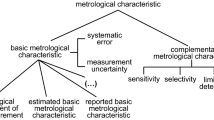Abstract
The role of human being as a part of a measuring system in a chemical analytical laboratory is discussed. It is argued that a measuring system in chemical analysis includes not only measuring instruments and other devices, reagents and supplies, but also a sampling inspector and/or analyst performing a number of important operations. Without this human contribution, a measurement cannot be carried out. Human errors, therefore, influence the measurement result, i.e., the measurand estimate and the associated uncertainty. Consequently, chemical analytical and metrological communities should devote more attention to the topic of human errors, in particular at the design and development of a chemical analytical/test method and measurement procedure. Also, mapping human errors ought to be included in the program of validation of the measurement procedure (method). Teaching specialists in analytical chemistry and students how to reduce human errors in a chemical analytical laboratory and how to take into account the error residual risk, is important. Human errors and their metrological implications are suggested for consideration in future editions of the relevant documents, such as the International Vocabulary of Metrology (VIM) and the Guide to the Expression of Uncertainty in Measurement (GUM).
Similar content being viewed by others
References
Kuselman I, Pennecchi F (2016) IUPAC/CITAC guide: classification, modeling and quantification of human errors in a chemical analytical laboratory (IUPAC Technical Report). Pure Appl Chem 88(5):477–515
Kuselman I, Pennecchi F (2015) Human errors and measurement uncertainty. Metrologia 52:238–243
Neumann TW (1966) Automated laboratories for scientific exploration of Mars. J Spacecr Rockets 3(12):1749–1755
Brown D, Cole S, Webster G et al (2013) The Mars science laboratory landing. World Neurosurg 79(2):223–242. doi:10.1016/j.wneu.2013.01.099
ISO/TS 22367 (2008) Medical laboratories—reduction of error through risk management and continual improvement. ISO, Geneva
Homeyer PK, Galloway J (2007) Planning a new analytical laboratory for an uranium mine taking automation into consideration. In: The fourth Southern African conference on base metals. http://www.saimm.co.za/Conferences/BM2007/149-154_Hofmeyr.pdf
Homeyer PK (2009) Review of the current status of automation of sample preparation methods and analysis in analytical laboratories in the heavy mineral mining industry. In: The seventh international heavy minerals conference ‘What next’. http://www.saimm.co.za/Conferences/HMC2009/035-038_Hofmeyr.pdf
Armbruster DA, Overcash DR, Reyes J (2014) Clinical chemistry laboratory automation in the 21st century—Amat victoria curam (Victory loves careful preparation). Clin Biochem Rev 35(3):143–153
BIPM, IEC, IFCC, ILAC, ISO, IUPAC, IUPAP and OIML (2012) International vocabulary of metrology—basic and general concepts and associated terms (VIM). Joint Committee for Guides in Metrology, JCGM 200:2012. Available from http://www.bipm.org/vim
BIPM, IEC, IFCC, ILAC, ISO, IUPAC, IUPAP and OIML (2008) Evaluation of measurement data—guide to the expression of uncertainty in measurement (GUM). Joint Committee for Guides in Metrology, JCGM 100:2008. Available from http://www.bipm.org/en/publications/
ISO/IEC 17025 (2005) General requirements for the competence of testing and calibration laboratories. ISO, Geneva
Barwick VJ, Prichard E (eds) (2011) Eurachem guide: terminology in analytical measurement—introduction to VIM3. Available from http://www.eurachem.org
Ramsey MH, Ellison SLR (eds) (2007) Eurachem/CITAC guide: measurement uncertainty arising from sampling. A guide to methods and approaches. Available from http://www.eurachem.org
Bashkansky E, Gadrich T, Kuselman I (2012) Interlaboratory comparison of test results of an ordinal or nominal binary property: analysis of variation. Accred Qual Assur 17:239–243
ISO 13528 (2015) Statistical methods for use in proficiency testing by interlaboratory comparisons. ISO, Geneva
Pendrill R, Petersson N (2016) Metrology of human-based and other qualitative measurements. Meas Sci Technol. doi:10.1088/0957-0233/27/9/094003
ISO/TR 79 (2015) Reference materials—examples of reference materials for qualitative properties, ISO, Geneva
Huber L (1999) Validation and quantification in analytical laboratories. Interpharm Press Inc., USA, p 318
Magnusson B and Ornemark U (eds) 2nd ed (2014) Eurachem guide: the fitness for purpose of analytical methods—a laboratory guide to method validation and related topics. Available from http://www.eurachem.org
ICH Harmonized Tripartite Guidelines Q2(R1) (2005) Validation of analytical procedures: Text and methodology. Available from http://www.ich.org
ISO 15189 (2007) Medical laboratories—particular requirements for quality and competence. ISO, Geneva
Ellison S L R and Williams A (eds) (2012) Eurachem/CITAC Guide: Quantifying uncertainty in analytical measurement, 3rd edn. Available from http://www.eurachem.org
Ortner HM (2000) The human factor in quality management. Accred Qual Assur 5:130–141
BIPM, IEC, IFCC, ILAC, ISO, IUPAC, IUPAP and OIML (2008) Evaluation of measurement data—supplement 1 to the “Guide to the expression of uncertainty in measurement”—propagation of distributions using a Monte Carlo method. Joint Committee for Guides in Metrology, JCGM 101:2008. Available from http://www.bipm.org/en/publications/
BIPM, IEC, IFCC, ILAC, ISO, IUPAC, IUPAP and OIML (2011) Evaluation of measurement data—supplement 2 to the “Guide to the expression of uncertainty in measurement”—models with any number of output quantities. Joint Committee for Guides in Metrology, JCGM 102:2011. Available from http://www.bipm.org/en/publications/
Author information
Authors and Affiliations
Corresponding author
Additional information
The author Walter Bich is Convener of the Joint Committee for Guides in Metrology (JCGM) Working Group 1 (Guide to the Expression of Uncertainty in Measurement—GUM). The opinion expressed in this paper does not necessarily represent the view of this Working Group.
Papers published in this section do not necessarily reflect the opinion of the Editors, the Editorial Board and the Publisher.
A critical and constructive debate in the Discussion Forum or a Letter to the Editor is strongly encouraged!
Rights and permissions
About this article
Cite this article
Kuselman, I., Pennecchi, F., Bich, W. et al. Human being as a part of measuring system influencing measurement results. Accred Qual Assur 21, 421–424 (2016). https://doi.org/10.1007/s00769-016-1239-3
Received:
Accepted:
Published:
Issue Date:
DOI: https://doi.org/10.1007/s00769-016-1239-3



